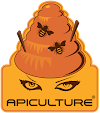Certainly, there are areas that are doing better, but for the most part it’s the same story. The reason I mention this is not to express my disappointment in the honey crop, but rather to warn of insufficient reserves in the hives. Right now I am feeding because they don't have, nor can they make, enough honey to sustain the colony, let alone get it through winter. Nutrition is one of the most under-recognized factors in colony health. Be sure your bees are not hungry bees.
- At this time of year, when you begin feeding the bees, the syrup should be the heavy 2:1 mix – two parts sugar to one part water. (Editor’s note: This mix is difficult to mix and will require heating. Use a large Dutch oven or similar stainless steel pot. All of the sugar and water can be put into the pot at the same time and then heated, stirring frequently, until the mixture is clear, indicating that all the sugar has dissolved. You will have virtually identical results if your measurements are based on weight or volume. In other words: Five pounds sugar and two and one-half pounds of water for a total weight of seven and one-half pounds. Two and one-half pounds of water is 5 cups.) Eight cups of sugar four cups of water.)
Feeding can be tricky. I have tried the boardman feeder that comes with the beginners kit. The problem with these is if it during a dearth, when you would feed, it invites robbing. The frame feeder is better since it is in the hive and doesn't invite robbing and it holds more syrup, but LOTS of bees drown in these and you must go into the hive to fill and check.
By far the best option that I have found is by bee works. It holds 2 quarts and if used on a inner cover with out other holes you don't even have to suit up to fill it. I found that if you use a inner cover with other holes that don't have hardware cloth that they will push up the lid and then you have dead bees. Today I switched the inner cover with one that is screened except for a bar that runs across the middles with a bee escape hole. Perfect! Ventilation without having to suit up to fill or dead bees.sres have bargains on su






